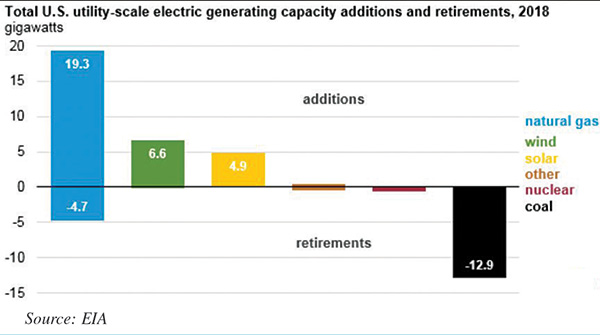April 2019, Vol. 246, No. 4
Global News
Natural Gas Fuels More Than 60% of U.S. Generating Capacity Added in 2018
The United States added its largest electric generating capacity in 15 years during 2018, with natural gas fueling 62% of all utility-scale additions according to the Energy Information Administration (EIA). The additions totaled 31.3 gigawatts (GW) of generating capacity in 2018, while 18.7 GW of capacity were retired. It was the largest increase since 48.8 GW were added in 2003.
U.S. utility-scale additions in 2018 primarily consisted of natural gas (62%), wind (21%), and solar photovoltaic (16%) capacity. The remaining 2% of additions came primarily from hydroelectric and battery storage capacity.
Almost 90% of the 19.3 GW of the natural gas-fired capacity in the United States added in 2018 were combined-cycle generators, the most efficient natural gas-fired generating technology. Pennsylvania accounted for almost 25% (4.4 GW) of all 2018 domestic natural gas additions, and three other states – Maryland, Virginia, and Florida – accounted for about 30%.
The 18.7 GW of U.S. generating capacity that retired in 2018 were primarily coal (69%), natural gas (25%), and nuclear (3%) generators, with the remainder composed mostly of hydroelectric and petroleum generating capacity.
Although 4.7 GW of U.S. natural gas-fired capacity retired in 2018, 93% (4.4 GW) of those retirements were from natural gas steam and combustion turbine units, which are less efficient natural gas-fired generating technologies that typically operate at lower capacity factors than more efficient combined-cycle units.






Comments